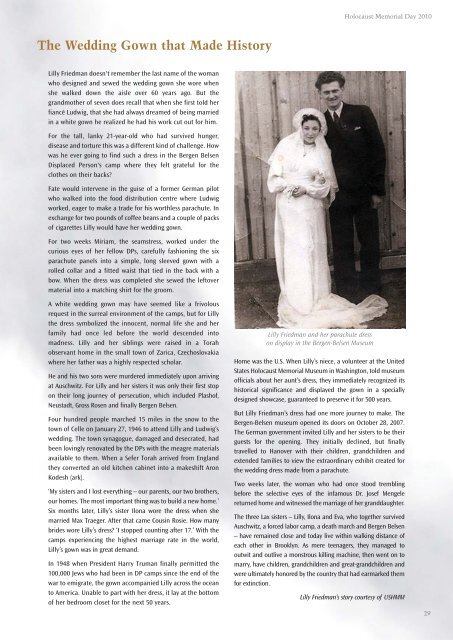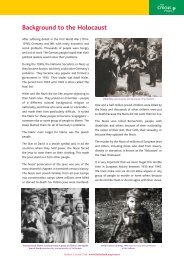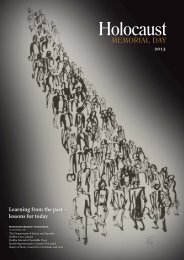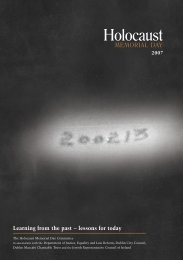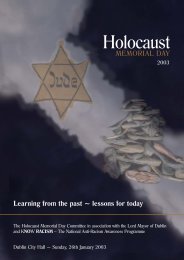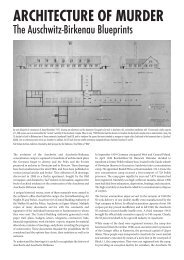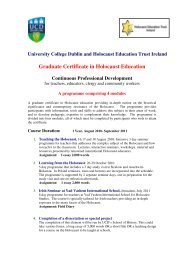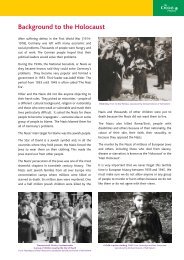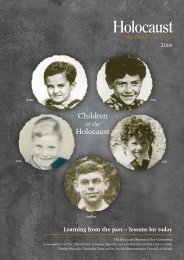Learning from the past ~ lessons for today - Holocaust Education ...
Learning from the past ~ lessons for today - Holocaust Education ...
Learning from the past ~ lessons for today - Holocaust Education ...
Create successful ePaper yourself
Turn your PDF publications into a flip-book with our unique Google optimized e-Paper software.
<strong>Holocaust</strong> Memorial Day 2010<br />
The Wedding Gown that Made History<br />
Lilly Friedman doesn't remember <strong>the</strong> last name of <strong>the</strong> woman<br />
who designed and sewed <strong>the</strong> wedding gown she wore when<br />
she walked down <strong>the</strong> aisle over 60 years ago. But <strong>the</strong><br />
grandmo<strong>the</strong>r of seven does recall that when she first told her<br />
fiancé Ludwig, that she had always dreamed of being married<br />
in a white gown he realized he had his work cut out <strong>for</strong> him.<br />
For <strong>the</strong> tall, lanky 21-year-old who had survived hunger,<br />
disease and torture this was a different kind of challenge. How<br />
was he ever going to find such a dress in <strong>the</strong> Bergen Belsen<br />
Displaced Person's camp where <strong>the</strong>y felt grateful <strong>for</strong> <strong>the</strong><br />
clo<strong>the</strong>s on <strong>the</strong>ir backs?<br />
Fate would intervene in <strong>the</strong> guise of a <strong>for</strong>mer German pilot<br />
who walked into <strong>the</strong> food distribution centre where Ludwig<br />
worked, eager to make a trade <strong>for</strong> his worthless parachute. In<br />
exchange <strong>for</strong> two pounds of coffee beans and a couple of packs<br />
of cigarettes Lilly would have her wedding gown.<br />
For two weeks Miriam, <strong>the</strong> seamstress, worked under <strong>the</strong><br />
curious eyes of her fellow DPs, carefully fashioning <strong>the</strong> six<br />
parachute panels into a simple, long sleeved gown with a<br />
rolled collar and a fitted waist that tied in <strong>the</strong> back with a<br />
bow. When <strong>the</strong> dress was completed she sewed <strong>the</strong> leftover<br />
material into a matching shirt <strong>for</strong> <strong>the</strong> groom.<br />
A white wedding gown may have seemed like a frivolous<br />
request in <strong>the</strong> surreal environment of <strong>the</strong> camps, but <strong>for</strong> Lilly<br />
<strong>the</strong> dress symbolized <strong>the</strong> innocent, normal life she and her<br />
family had once led be<strong>for</strong>e <strong>the</strong> world descended into<br />
madness. Lilly and her siblings were raised in a Torah<br />
observant home in <strong>the</strong> small town of Zarica, Czechoslovakia<br />
where her fa<strong>the</strong>r was a highly respected scholar.<br />
He and his two sons were murdered immediately upon arriving<br />
at Auschwitz. For Lilly and her sisters it was only <strong>the</strong>ir first stop<br />
on <strong>the</strong>ir long journey of persecution, which included Plashof,<br />
Neustadt, Gross Rosen and finally Bergen Belsen.<br />
Four hundred people marched 15 miles in <strong>the</strong> snow to <strong>the</strong><br />
town of Celle on January 27, 1946 to attend Lilly and Ludwig’s<br />
wedding. The town synagogue, damaged and desecrated, had<br />
been lovingly renovated by <strong>the</strong> DPs with <strong>the</strong> meagre materials<br />
available to <strong>the</strong>m. When a Sefer Torah arrived <strong>from</strong> England<br />
<strong>the</strong>y converted an old kitchen cabinet into a makeshift Aron<br />
Kodesh (ark).<br />
‘My sisters and I lost everything – our parents, our two bro<strong>the</strong>rs,<br />
our homes. The most important thing was to build a new home.’<br />
Six months later, Lilly’s sister Ilona wore <strong>the</strong> dress when she<br />
married Max Traeger. After that came Cousin Rosie. How many<br />
brides wore Lilly’s dress? ‘I stopped counting after 17.’ With <strong>the</strong><br />
camps experiencing <strong>the</strong> highest marriage rate in <strong>the</strong> world,<br />
Lilly’s gown was in great demand.<br />
In 1948 when President Harry Truman finally permitted <strong>the</strong><br />
100,000 Jews who had been in DP camps since <strong>the</strong> end of <strong>the</strong><br />
war to emigrate, <strong>the</strong> gown accompanied Lilly across <strong>the</strong> ocean<br />
to America. Unable to part with her dress, it lay at <strong>the</strong> bottom<br />
of her bedroom closet <strong>for</strong> <strong>the</strong> next 50 years.<br />
Lilly Friedman and her parachute dress<br />
on display in <strong>the</strong> Bergen-Belsen Museum<br />
Home was <strong>the</strong> U.S. When Lilly’s niece, a volunteer at <strong>the</strong> United<br />
States <strong>Holocaust</strong> Memorial Museum in Washington, told museum<br />
officials about her aunt’s dress, <strong>the</strong>y immediately recognized its<br />
historical significance and displayed <strong>the</strong> gown in a specially<br />
designed showcase, guaranteed to preserve it <strong>for</strong> 500 years.<br />
But Lilly Friedman’s dress had one more journey to make. The<br />
Bergen-Belsen museum opened its doors on October 28, 2007.<br />
The German government invited Lilly and her sisters to be <strong>the</strong>ir<br />
guests <strong>for</strong> <strong>the</strong> opening. They initially declined, but finally<br />
travelled to Hanover with <strong>the</strong>ir children, grandchildren and<br />
extended families to view <strong>the</strong> extraordinary exhibit created <strong>for</strong><br />
<strong>the</strong> wedding dress made <strong>from</strong> a parachute.<br />
Two weeks later, <strong>the</strong> woman who had once stood trembling<br />
be<strong>for</strong>e <strong>the</strong> selective eyes of <strong>the</strong> infamous Dr. Josef Mengele<br />
returned home and witnessed <strong>the</strong> marriage of her granddaughter.<br />
The three Lax sisters – Lilly, Ilona and Eva, who toge<strong>the</strong>r survived<br />
Auschwitz, a <strong>for</strong>ced labor camp, a death march and Bergen Belsen<br />
– have remained close and <strong>today</strong> live within walking distance of<br />
each o<strong>the</strong>r in Brooklyn. As mere teenagers, <strong>the</strong>y managed to<br />
outwit and outlive a monstrous killing machine, <strong>the</strong>n went on to<br />
marry, have children, grandchildren and great-grandchildren and<br />
were ultimately honored by <strong>the</strong> country that had earmarked <strong>the</strong>m<br />
<strong>for</strong> extinction.<br />
Lilly Friedman’s story courtesy of USHMM<br />
29


